|
|
| During the past century, global surface temperatures have increased at a rate near 0.6°C/century (1.1°F/century), but this trend has dramatically increased to a rate approaching 2.0°C/century (3.6°F/century) during the past 25 years. There have been two sustained periods of warming, one beginning around 1910 and ending around 1945, and the most recent beginning about 1976. Temperatures during the latter period of warming have increased at a rate comparable to the rates of warming projected to occur during the next century with continued increases of anthropogenic greenhouse gases. |
| Satellite measurements of lower tropospheric temperatures (the lowest 8 kilometers of the Earth's atmosphere) collected since 1979 also indicate warming, but not to the extent shown by surface observations. The adjacent figure shows annual anomalies for both the surface and lower tropospheric temperatures from 1979 to 2001 (excluding Dec of 2001). (Satellite measurements of lower tropospheric temperatures are collected by NOAA's TIROS-N polar-orbiting satellites via the Microwave Sounding Unit (MSU) and adjusted for time-dependent biases by NASA and the Global Hydrology and Climate Center at the University of Alabama in Huntsville). | 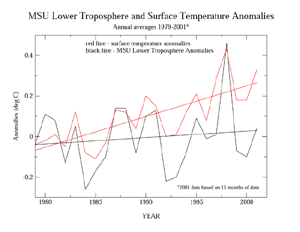 larger image |
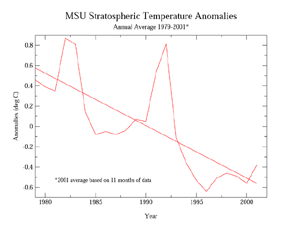 larger image |
While lower tropospheric temperatures as measured by the MSU indicate increasing temperature over the last 2 decades, stratospheric (14 to 22 km / 9 to 14 miles) temperatures have been decreasing. This is thought to be consistent with the depletion of ozone in the lower stratosphere. The large increase in 1982 was caused by the volcanic eruption of El Chichon, and the increase in 1991 was caused by the eruption of Mt. Pinatubo in the Philippines. |
* The annual values for both MSU graphs were calculated by averaging monthly anomaly values. For all years, 12 monthly anomalies were averaged, except for 2001, where only 11 months of data exist. The full 12 months will be used in the final annual report in mid-January.
 Regional Temperatures
Regional Temperatures
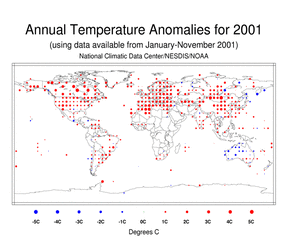 larger image |
Despite pre-existing La Ni�a conditions, global temperatures were above average during 2001. The adjacent figure depicts the warmer than average temperatures that were widespread across much of the United States as well as most of Europe. Temperatures in these regions were 1-3°C (1.8-5.4°F) above the 1961-1990 average. The only widespread area of negative anomalies was across Australia, where temperatures were between 1 and 3°C (1.8-5.4°F) cooler than average.
|
| Notable temperature extremes during 2001 included one of the harshest winters in decades across Siberia and Mongolia. Extreme minimum temperatures as low as -70°C (-94°F) were observed in the Kemerovo region of Russia during mid-January. High heat affected drought-plagued areas of the Middle East, with maximum temperatures reaching as high as 50°C (122°F) in parts of Pakistan during early May, resulting in dozens of deaths. |
 Global Precipitation
Global Precipitation
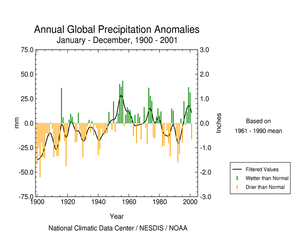 larger image |
Global precipitation is expected to be below the 1961-1990 average in 2001. A drought which has persisted for nearly 3 years continued in 2001 across Afghanistan, Pakistan and neighboring countries. In Iran alone, estimated agricultural losses approached $2.6 billion (USD). Much of Central America experienced drought during the middle part of the year, which is traditionally the rainy season. Late season tropical activity eased drought in these areas, although drought in Honduras and neighboring regions continued through the latter part of 2001. In Africa, drought in Kenya persisted during 2001, despite one of the wettest Januaries in 40 years. In Australia, drought affected much of Western Australia and parts of Queensland. |
| Several typhoons brought excessive rains to parts of southeast Asia, including the southeast coast of China, Taiwan, the Philippines and Vietnam. Monsoon rains in southeast Asia promoted extensive flooding along the Mekong Delta with at least several hundred deaths between August and October. Across Siberia, spring rains and a rapid thaw brought flooding across a vast area from the Ural Mountains to the Russian Far East, with some of the worst flooding in the Sakha region along the Lena River. A third consecutive year of spring flooding along the Tisza River in Hungary displaced tens of thousands of people from their homes, with the Tisza rising to its highest level in 100 years by early March. |

NOAA's National Climatic Data Center is the world's largest active archive of weather data. The preliminary temperature and precipitation rankings are available from the center by calling: 828-271-4800.
NOAA works closely with the academic and science communities on climate-related research projects to increase the understanding of El Niño and improve forecasting techniques. NOAA's Climate Prediction Center monitors, analyzes and predicts climate events ranging from weeks to seasons for the nation. NOAA also operates the network of data buoys and satellites that provide vital information about the ocean waters, and initiates research projects to improve future climate forecasts.

For further information, contact:
Jay Lawrimore
NOAA/National Climatic Data Center
151 Patton Avenue
Asheville, NC 28801-5001
fax: 828-271-4328
email: Jay.Lawrimore@noaa.gov
-or-
Scott Stephens
NOAA/National Climatic Data Center
151 Patton Avenue
Asheville, NC 28801-5001
fax: 828-271-4328
email: Scott Stephens@noaa.gov
 NCDC / Climate Monitoring / Climate of 2001 / Search / Help
NCDC / Climate Monitoring / Climate of 2001 / Search / Help
Downloaded Monday, 13-Oct-2008 05:35:20 EDT
Last Updated Tuesday, 12-Jul-2005 08:25:29 EDT by Karin.L.Gleason@noaa.gov
Please see the NCDC Contact Page if you have questions or comments.


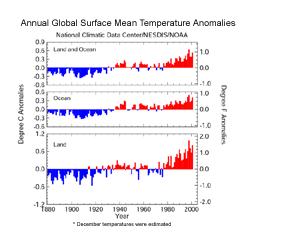 larger image
larger image